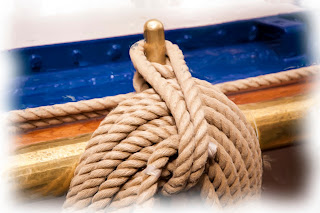Painter (rope)
A painter is a rope that is attached to the bow of a dinghy, or another small boat, and used for typing up or towing. Ideally, the length of the painter should be no longer than the length of the boat, especially on small craft, to prevent fouling the propeller of an outboard engine.
Canoes being used in moving water or whitewater are rigged with a painter at both the bow and the stern. In addition to the functions listed above, a canoe's painter can be used for lining the boat down difficult sections, self-rescue, and boat recovery.
Knots
A knot is a method of fastening or securing linear material such as rope by tying or interweaving. It may consist of a length of one or several segments of rope, string, webbing, twine, strap or even chain interwoven such that the line can bind itself to another line or an object. Knots have been the subject of interest for their ancient origins, their common uses, and the area of knot theory.
There is a large variety of knots, each with properties that make it suitable for a range of tasks. Some knots are used to attach the knotting material to other objects. Some knots are used to bind or construct objects. Decorative knots are used to produce attractive patterns.
While some people can look at diagrams or photos and tie the illustrated knots, others learn best by watching how a knot is tied. Knot tying skills are often taught by sailors, scouts, and fishermen.
Truckers in need of securing a load may use a trucker's hitch, gaining mechanical advantage. Knots can save spelunkers from being buried under a rock. Many knots can also be used as makeshift tools. For example, the bowline can be used as a rescue loop, and the munter hitch can be used for belaying. The diamond hitch was widely used to tie packages on to donkeys and mules.
In hazardous environments, such as mountains, knots are very important. In the event of someone falling into a ravine or a similar terrain feature, with the correct equipment and knowledge of knots, a rappel system can be set up.
There is a large variety of knots, each with properties that make it suitable for a range of tasks. Some knots are used to attach the knotting material to other objects. Some knots are used to bind or construct objects. Decorative knots are used to produce attractive patterns.
While some people can look at diagrams or photos and tie the illustrated knots, others learn best by watching how a knot is tied. Knot tying skills are often taught by sailors, scouts, and fishermen.
Truckers in need of securing a load may use a trucker's hitch, gaining mechanical advantage. Knots can save spelunkers from being buried under a rock. Many knots can also be used as makeshift tools. For example, the bowline can be used as a rescue loop, and the munter hitch can be used for belaying. The diamond hitch was widely used to tie packages on to donkeys and mules.
In hazardous environments, such as mountains, knots are very important. In the event of someone falling into a ravine or a similar terrain feature, with the correct equipment and knowledge of knots, a rappel system can be set up.




Comments
Post a Comment